Mat exercises for spinal cord injury survivors are ideal because a mat helps lower the risk of falling or straining the joints. After a spinal cord injury, survivors may struggle with movement and sitting up-right due to decreased strength in the core muscles.
Mat exercises are a good stepping stone for developing core strength and improving posture, especially for individuals using a wheelchair. In addition, it provides an opportunity to practice fundamental positions and movement patterns that will aid in functional activities such as transfers and bed mobility.
Rehabilitation exercise is an important element in spinal cord injury recovery that should be performed on a consistent basis to promote neuroplasticity (central nervous system’s ability to rewire itself) and improve mobility.
To ensure your safety during spinal cord injury exercises, we’ve gathered 10 of the most effective mat activities for spinal cord injury, including exercises for patients with hemiplegia (paralysis on one side of the body) or paraplegia (paralysis of the lower limbs) to do at home.
Benefits of Exercising on a Mat After Spinal Cord Injury
Mats provide many benefits during exercise, especially after a spinal cord injury. Mats can make it smoother to exercise because of its protective layers such as reducing the risk of falling or further injury. Studies have also shown that performing core exercises on a mat can help improve spine stability and increase the control of the affected limbs.
Each type of mat has their own unique benefits. For example, a Pilates or yoga mat is a non-slip mat that provides traction and a little bit of cushioning for the body, helping prevent injury and falling. These are usually light-weight and can be rolled up or folded for better portability and storage. Thicker exercise or gym mats provide extra cushion, are usually heavier but more durable, and help prevent muscle aches and pains while exercising.
Some factors to consider when thinking about purchasing a mat include portability, whether it’s easy to clean, and affordability. Most are light-weight, sweat-resistant, and durable meaning they can last you all throughout your spinal cord injury recovery journey, although materials between mats may vary.
Choosing the Right Mat for Spinal Cord Injury Exercises

Choosing the right mat for spinal cord injury exercises is essential. To find the most suitable one for you, it helps to take into account a couple of factors including what type of workouts you are aiming for.
For instance, exercise mats usually provide more support for advanced or higher intensity workouts, while yoga or Pilates mats tend to focus on improving balance and grip, both which are extremely important. In fact, studies indicate that the most effective workout mat is one that provides balance, grip, and comfort.
When buying a mat after spinal cord injury, it helps to keep in mind the:
- Size of the mat: Smaller mats can help with core exercises and stretching, while larger mats offer a bigger area to do other workouts. Also take into account the thickness of the mat. Thinner mats are lighter and easier to transport, but thicker mats provide more cushion and support after a spinal cord injury.
- Durability: Some mats are easier to clean and offer more traction and durability depending on the materials, such as foam, silicone, or rubber. Certain mats may also feature a protective coating and resistance against shoes, equipment, odor, and wear.
- Portability: lighter-weight mats can often be rolled up and easily transportable, but usually provide less cushion. On the other hand, heavier and thicker mats aren’t as portable but typically offer more durability and cushion.
Lastly, an ideal mat is one that matches your individual needs. Take into account its intended use, whether you plan to take it when travelling or going to therapy sessions, or will use it solely at home and can keep a heavier exercise mat in a designated space. Having a mat that is quick and simple to use is essential during your home exercise program for spinal cord injury recovery.
Mat Exercises for Spinal Cord Injury Survivors

Exercise after a spinal cord injury is crucial to stimulate the central nervous system and activate neuroplasticity, which helps strengthen the neural pathways that may have been affected after a spinal cord injury.
Exercising and moving the affected muscles as much as possible is key to activating neuroplasticity and improving overall function. When neglected, lack of activity can increase the risk of complications after spinal cord injury such as pressure ulcers, weight gain, reduced metabolic rate, poor circulation, and muscle atrophy.
To lower the risk of complications, it’s important to perform high repetition of exercises, or massed practice. Practicing a skill consistently will train the nervous system to recognize that skill and strengthen its neural pathways.
While mat exercises can be quite challenging, do not feel discouraged. Every spinal cord injury is different as well as the outcomes for each person. Intensity is one of the variables that increases neuroplasticity. However, the goal is to feel challenged and not frustrated.
Many of the mat exercises can be modified and adjusted to your ability level. Your therapist is also a great resource and can provide you with more mat exercises tailored to your condition; and the following mat exercises should be performed only with your therapist’s approval.
Here are 10 effective mat exercises for spinal cord injury:
1. Trunk Twist
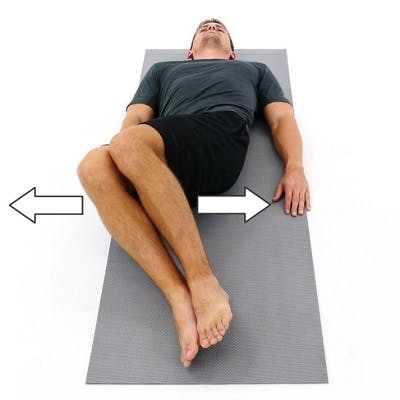
For this first mat exercise for spinal cord injury, begin by lying on your back with your knees together and bent. With your feet flat on the mat, slowly tilt your knees to one side using your abdominal and hip muscles. Your shoulders should stay on the mat and not move the entire time. If you have sensation, a gentle stretch may be felt along your back. Hold for 20-30 seconds and then tilt to the other side.
2. Bicycle Kicks
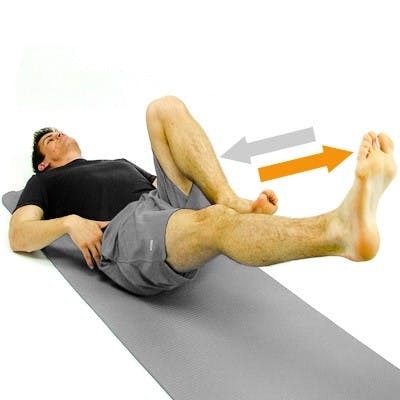
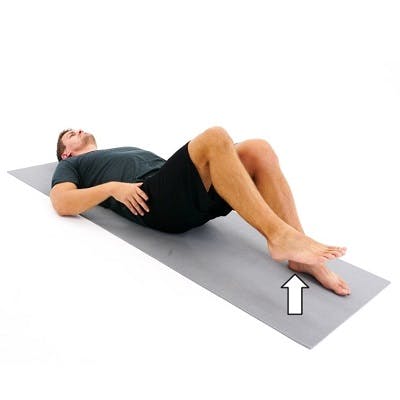
Lying on your back, raise and bend the right leg while the left leg is extended. Then, make pedaling motions with your legs, as if riding a bike. Try your best to keep your abdominals engaged and your back flat against the mat. The legs should alternate between bending and extending. If you have trouble holding your legs off the mat, try marching one knee up at a time instead. Repeat for 20 total (10 each side).
3. Bridges
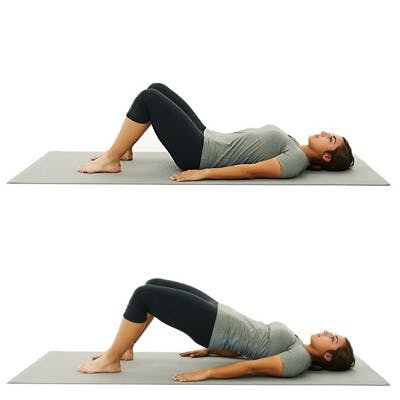
Lie on your back with your knees bent and your feet flat on the mat. Slowly lift your hips but keep your shoulders, arms, and head on the mat. Hold for 5 seconds and then gently lower your hips. Repeat 10 times.
4. Side-Leg Raises (Hip Abduction)
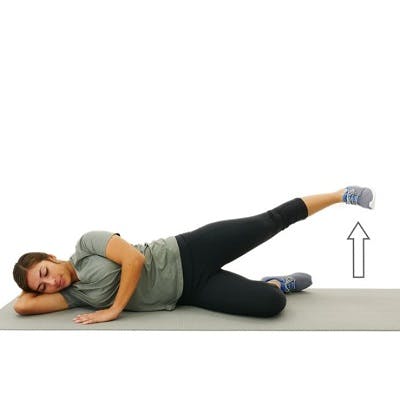
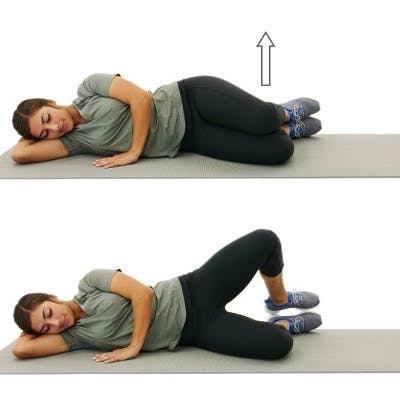
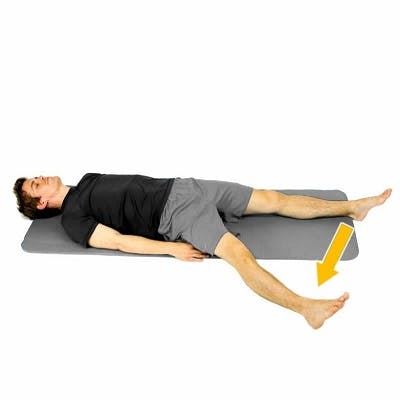
This exercise will help strengthen your gluteus muscles, stretch out your inner thigh, and reduce hip joint stiffness. Lie on your right side of the body and raise your left foot up towards the ceiling as high as you can. Hold the position for a few seconds before lowering your leg. If lifting with a straight leg is too difficult, try it with your knee bent as you open and close your leg like a clamshell. Another modification is to lay flat on your back as you move your leg out to the side and back in. Repeat 10 times alternating with the other side.
5. Superman

This mat exercise is excellent for developing strength of your back muscles and improving posture. Lie on your stomach with your arms out front. You can place a pillow under your stomach and hips for comfort. Lift your arms, legs, and head up until you’re mostly balancing on your torso. Make sure that your arms and legs stay straight and focus on stretching them outwards. Hold for 10-15 seconds, then repeat 5 times.
6. Cobra Stretch


Use this mat exercise to improve spine mobility and strengthen your back, shoulders and triceps. With your hands by your side, press through your palms as you lift your head and chest upward. Work towards being able to fully straighten your elbows. Your lower body and hips should remain on the mat, creating a slope with your body. If pressing through your hands is too difficult, try doing the same movement on your forearms and elbows instead. Hold for 15-20 seconds, breathing deeply. Repeat 5-10 times. If you feel any pinching or pain in your lower back, stop immediately.
7. Quadriceps Stretch
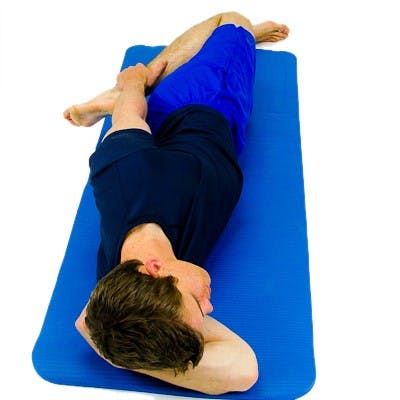
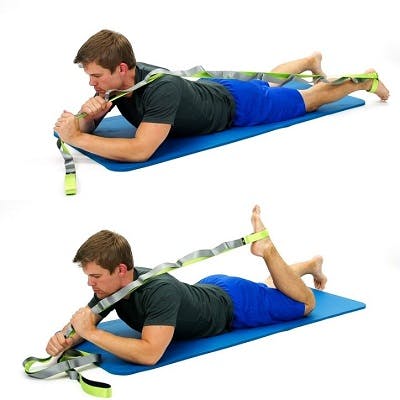
While laying on your side, reach for your foot or ankle and pull to bend your knee. A stretch should be felt along the front of the thigh. Hold for 20-30 seconds, remembering to breathe. You can also try this quadriceps stretch on your stomach, using a belt loop or strap to hook around the foot. Be careful not to over-stretch, especially if you have impaired sensation.
8. Hamstring Stretch

Having good hamstring flexibility is critical for spinal cord injury survivors to make changing positions, transfers, and dressing easier. Sit with your legs straightened and together in front of you. Slowly lean forward toward your toes and hold for 20-30 seconds. For more balance, bend one knee so that the bottom of that foot is touching the side of your other thigh. This will create a more stable base, but you’ll need to stretch one hamstring at a time. Then, lean towards the foot of your straightened leg. Repeat for both sides.
9. Calf Stretch
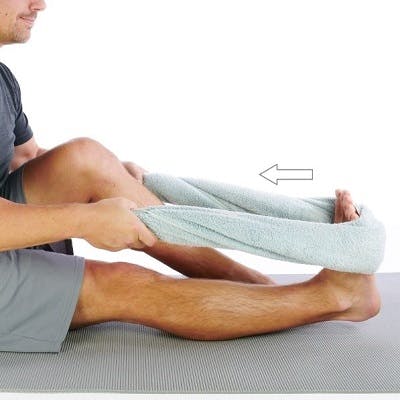
While in a seated position, place a towel around the ball of your foot and pull your ankle back until a stretch is felt on your calf area. Keep your knee in a straightened position during the stretch. Hold for 20-30 seconds and then switch sides.
10. Knee Push-Ups
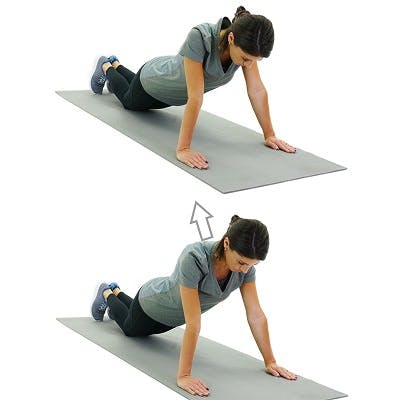
This advanced exercise may require more strength and mobility. Only perform if you feel comfortable. To start, get on your hands and knees and move your hands and upper body forward, creating a slope in your back all the way to your knees.
Facing the floor, bend your elbows to a 90° angle to lower your body. Push against the ground, straightening your elbows to raise yourself back up. For an added challenge you can lift your feet off the floor.
Bonus Advanced Mat Exercises
If you’re looking for a bit more challenge, here are some additional, more advanced mat exercises to try. As always, make sure to consult with your physical therapist beforehand to determine if they are safe for you to do.
11. Shoulder Reaches
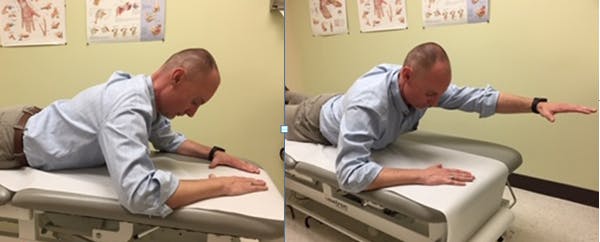
This mat exercise is excellent for promoting shoulder stability, strength and mobility in a weight-bearing position. Start by laying on your stomach propped on your elbows. Make sure that your elbows are positioned directly beneath your shoulders. Slowly alternate lifting one arm straight forward and back down, without letting the shoulder on your down arm sag or collapse. Repeat for 20 repetitions.
12. Prone Snow Angels

For this challenging mat exercise, start on your stomach with your forehead resting on a rolled up towel to allow you to breathe. With both arms, slowly sweep them out to the side, overhead, and back down to your hips. It’s okay if your arms are grazing the floor, but bonus points if you can do the full motion without letting your hands touch the ground at all! Perform 10 repetitions, slow and controlled.
13. Rolling

Practicing rolling as a mat exercise not only is good for bed mobility, but also to help you learn how to maneuver your body using your arms and trunk, if applicable. To roll to the right, start by lying on your back with your left leg crossed over the right ankle. Using momentum, quickly lift your head as you reach your left arm across your chest for the roll. Use your left hand on the floor/mat in front of you to stabilize yourself once you are laying on your side. Push through your left arm to roll onto your back again. Repeat 5 times for both sides.
While the mat exercises vary in intensity and difficulty, they can all be adjusted to your ability level. Remember to only do what you can and take breaks or stop when necessary. Also, be sure to consult with your doctor and/or therapist to check if the mat exercises above are safe and suitable for your condition.
Promoting Spinal Cord Injury Recovery Through Exercise

Motor control (mobility) is often impaired after a spinal cord injury, the severity of which depends on the type of injury (incomplete vs. complete) and level of injury. With a complete SCI, survivors do not preserve movement or sensation below the level of injury.
However, with an incomplete SCI there are usually some motor and sensory neural pathways remaining, which are capable of neuroplasticity. Neuroplasticity helps strengthen these existing pathways and also create new ones.
Still, it’s important for survivors with a complete spinal cord injury to perform mat exercises to promote proper blood flow and improve oxygen consumption. For individuals with an incomplete spinal cord injury, mat exercises are essential to activate neuroplasticity and restore mobility in the affected limbs. For those with a complete spinal cord injury, the above mat exercises can help you preserve joint and muscle health, increase strength and mobility, and relearn how to maneuver your body. The more you practice, the higher the chances of regaining overall function.
Effective Mat Exercises for Spinal Cord Injury
Though it may seem like just another piece of exercise equipment, mats are incredibly useful and versatile. Various types of mats provide their own unique benefits, making it an attractive therapy tool for spinal cord injury survivors.
Exercising after a spinal cord injury can be challenging for a number of reasons, including lack of strength. Fortunately, mats help survivors exercise more freely by limiting stress on the joints, stretching the muscles, and increasing core strength.
We hope this article helped you understand the importance of exercising, the benefits of using a mat, and encouraged you to engage in mat exercises for spinal cord injury.











